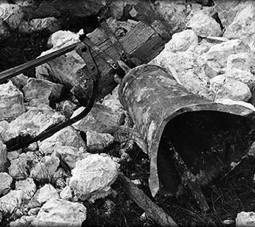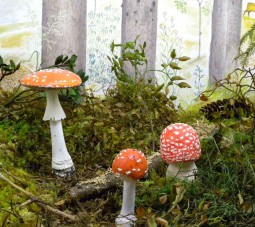
THE MUMMIES OF VENZONE
The natural mummification of the Mummies of Venzone is due to particular environmental conditions that occurred in some tombs of the Cathedral in which the Hypha bombicina Pers developed, a mold with the property of dehydrating tissues inhibiting decomposition. The bodies date back to an era that goes from 1348 to 1881, the year in which the cemetery inside the Cathedral was reclaimed and placed in the current site, outside the Old Town. The mummification process of the bodies occurred on average within the first year of their burial.
The oldest mummy, the Hunchback, was discovered in 1647 during some work to enlarge the Cathedral; the body was found in a fourteenth-century tomb located below the current Chapel of the Rosary. The other mummies date back to the 18th and 19th centuries.
In 1845, the mummies of Venzone were moved from the Crypt of the Cathedral to the Upper Chapel and, following the strong earthquakes of May 6, 1976, 15 of the 21 mummies kept there were extracted from the ruins of the Rotunda of San Michele, all the bodies were substantially intact.
The Mummies of Venzone, in all 5 bodies currently open to visitors, are kept in the crypt of the cemetery chapel of San Michele (sec. XIII), located in the churchyard of the Cathedral of St. Andrew the Apostle.
Address: Cemetery Chapel of Saint Michel, Piazzetta Duomo – 33010 VENZONE (UD)
Opening: permanent exhibition.
Opening time: summer 09.00-19.00 / winter 09.00-17.00

TIERE MOTUS. HISTORY OF AN EARTQUAKE AND ITS PEOPLE
The permanent museum dedicated to the 1976 earthquake guides the visitor along the significant stages of the path of rebirth started on May 6 of that same year and that has characterized the history of Friuli up to the present day.
The unusual title combines the expressions of two noble and ancient languages proper to the history of this land: the Friulian Tiere (=Terra) and the Latin Motus (=Moto).
Tiere as a meaning of identity, deep emotions and a high sense of belonging to the land and culture of Friuli.
Motus as an intense reminder of the origins and mother history, but above all the strength of a people to overcome two millennia of human events and hostile natural events.
Orcolat, the terrifying creature that in popular tradition impersonates the earthquake, is revived thanks to virtual reality techniques that simulate the collapse of the Cathedral of Venzone during those terrible tremors. The 3D graphics simulation was carried out on a scientific basis with the help of a team of experts from various sectors, from engineering to computer graphics.
The rooms of the first floor tell, chronologically, first, and thematic, then, the crucial moments of the earthquake and reconstruction through the exposure of photographs, films, documents and illustrative schemes that show the close intertwining of technical aspects-scientific, socio-economic, political-administrative.
In the images that recount the first moments of the tragedy, the faces depicted express bewilderment in front of nature, but also reveal moral strength, tenacity and determination in a generous race for aid and solidarity.
A room of the museum is dedicated to the summer of 1976: an extremely difficult period during which the population of the earthquake is forced to live under the tents and life resumes with great difficulty. But this is also the time to make a strong case for participation in the decisions on reconstruction.
The new tremors recorded between 11 and 15 September 1976 are a devastating seismic swarm that plunges Friuli into an even more complex situation: autumn is told through the images of the exodus and the places of displacement. After the reconstruction: the years of the “baracche”, temporary houses, begin.
The second part of the exhibition is developed by thematic rooms: the legislative apparatus, studies for reconstruction (geology and seismic engineering), the “Government of Reconstruction” with state and regional institutions, the role of the Friulian Church, cultural heritage, planning and implementing instruments for the territory, the flow of funding and contributions, the development with the birth of another Friuli, consisting of major infrastructure works and industry, but also since the birth of the University and Civil Protection
Finally, the Gold Medal of Civil Merit awarded by the Head of State, the Flags of the Region and the 45 Municipalities disaster.
The museum concludes with a room dedicated to memory, in a multimedia journey in the large number of documents (audio, video, texts, images) produced at the time of the earthquake and that is enriched day by day.
The room is animated by a double projection: one represents on a model of the Region the repetition of the shocks of ’76 and their strength and the other reproduces, on a large wall, the names of the victims that appear and dissolve. Visitors can freely record their testimony on the “wall of memory”.
Address: Palazzo Orgnani-Martina, Via Mistruzzi, 4 – 33010 VENZONE (UD)
Opening: permanent exhibition
Opening time: Friday 14.00-18.00, Saturday and Sunday 10.00-18.00
June-July-August every day 10.00-18.00

BOSC: FORESTS, MAN, ECONOMY IN FRIULI VENEZIA GIULIA
Because of its geographical and natural characteristics and its historical vicissitudes, Friuli Venezia Giulia represents an ideal territory to present an effective compendium of the complex relations between man and the forest in their historical becoming, to raise awareness of the fundamental aspects of the functioning of the forest ecosystem and to draw the attention of all to the importance and urgency of finding appropriate solutions to the many problems of forests.
With an area of over 200 square meters and an exhibition that is divided into 3 rooms dedicated to as many specific themes, the exhibition aims to propose a synthetic picture of the aspects and problems of nature, ecological and historical and social of the forests of Friuli Venezia Giulia, making use of environmental reconstructions, photographic materials, samples and biological finds
A clear exhibition itinerary brings together the forest ecosystem, widely represented within the Parco Naturale delle Prealpi Giulie, in its historical-cultural, vegetational, faunistic, production, development and protection aspects.
The History of Forests is the initial theme of the first room. The evolution of the forest landscape of the region from the period of glaciation to the present day is illustrated through ancient written documents and cartographic, plastic and various forest tools. A special area is reserved for forest toponymy and for the disappeared trades: menàus (lumberjacks) and çatârs (rafts).
The second theme is forest ecosystems. The climatic and geolithological characteristics of the region are the starting point for the presentation of a wide model of pedological profile: from the coast to the high mountains are illustrated the main forest types of Friuli Venezia Giulia. Of great didactic value is the representation of fruits, seeds and woods of conifers and broad-leaved trees.
The second room houses the Forest Fauna. In the various forest environments such as the undergrouse, the beech, the mixed woods of conifers and the subalpine thicket, with realistic dioramas are evident the complex links between living organisms. The relationship between predators and preys finds an effective illustration in the feeding cycle of the tawny owl.
Special sections are dedicated to forest insects, nests, signs and traces of animals, soil fauna and wildlife emergencies.
The third room is dedicated to the functions and uses of the forests. A suitable path illustrates the physiology and the multiple functions of the trees. With plastic models, models of works, tools and schemes are addressed the problems arising from the interaction between man and forest in the difficult relationship of conservation and production. There is room for new forestry and a permanent forest inventory. Three hundred realistic models of mushrooms, mainly made of wood by a local enthusiast, complete the exhibition.
Address: Palazzo Orgnani-Martina, Via Mistruzzi, 4 – 33010 VENZONE (UD)
Opening: permanent museum.
Opening time: Friday 15.00-19.00, Saturday and Sunday 9.00-13.00 / 15.00-19.00.




